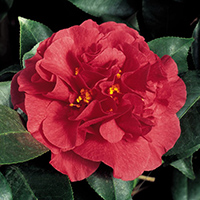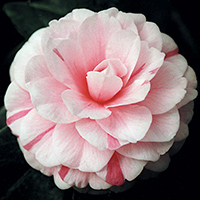
Camellias: Delightful Winter and Spring Blooming "Tea Flowers"
By Laurelynn Martin and Byron Martin
Last Updated: October 16, 2018
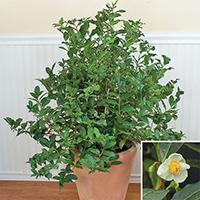 |
| Tea (Camellia sinensis) |
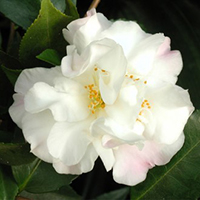 |
| Camellia ‘Scentuous’ (Camellia lutchuensis hybrid) |
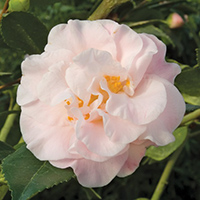 |
| Camellia ‘Kramer’s Supreme’ (Camellia japonica hybrid) |
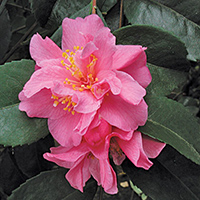 |
Camellias are well-loved flowers, nicknamed the “tea flower” with hundreds of different species and camellia varieties boasting unusual colors and forms. They are flowering shrubs from Asia and are well known for their prolific floral displays in winter and spring. Camellias were first grown in China and Japan where they were depicted in art, on wallpaper and even on early porcelain. In the early 1700’s, the camellia made its way to England. Camellia sinensis, the tea of commerce, was brought to England for the tea industry. Soon, the floral form of camellias found their way into the hearts of English gardeners. Camellia japonica varieties became center stage in the English horticultural scene in 1792 and have been well-loved around the world ever since. In southern climates, camellias are planted in landscapes and in the north they are used as container plants to bring color and fragrance to the winter months.
Planting Camellias Outside
As outside plants, camellias are ideal for the landscape and can be grown where winters are moderate in zones 7-9. Some of the hardier varieties can be grown in zone 6; they take temperatures down to zero and still flower when the warmer weather returns. We have tried some of the colder varieties in Connecticut but although we can get them to live, they usually don’t flower as the buds get damaged in the hard freezes.
Camellias as Container Plants
As container plants, camellias can be grown in a home that has cool windowsills. It’s important to keep the plant close to the glass and away from the room’s heat source. Camellias need cool winter temperatures to flower. Optimally, camellias, grown indoors, need night temperatures from 35° to 55°F. Daytime temps can be 60-70°F but cool nighttime temperatures are a must for flowering. When grown in the north in an unheated growing area, camellia plants should have some protection to the root ball.
Soil
As a potted plant, camellias are known to prefer an acidic soil so a potting mix without lime is beneficial.
Feeding Your Camellia
Since container-grown camellias are slow growers and only put on one flush of new leaf growth a year, they are considered to be light feeders. The addition of fertilizer needs to be given just as they start their new growth in late winter or early spring. As they prefer to be grown in an acid soil, camellias have a high magnesium requirement and once a year Epsom salt (a tablespoon to a gallon of water) can be given along with topdressing the soil with cottonseed meal (about a ½ inch sprinkled on the top of the soil). An acid fertilizer, like Holly tone, can also be used with great success. Remember only fertilize once a year in late winter or early spring and then let the new growth harden off as the days shorten in late summer and fall.
Light Level
As far as light goes, camellias naturally grow in open forests and get dappled sun light. Therefore, partial sun exposure is perfect for them and dark green leaves will ensue. We recommend an east or west window for best results. Some varieties can also be grown in full sun, although their leaves will lighten and they require more fertilizer with higher light levels.
The Trick to Flowering Camellias
Proper flowering requires cool nighttime temperatures that are below 60°F, preferably in the low fifties to freezing. The flowering of camellias begins with the spring/summer growth. The buds, although not visible to the eye, form on the ends of the newest growth and as late summer turns to fall the buds start to swell and thus begin the flower formation. It is in winter indoors or spring outside that the blooming period starts and at this time it is important to have cool night temperatures. If temperatures are too warm, or the environment too dry, the flower buds will fall off the plant. This is known as bud blast.
Pruning
Although camellias are shrubs, they often have an upright form. We recommend pruning when they are young to thicken the main branches. This pruning is done after flowering and just before the new growth in the spring. Stems or branches that are pruned often don’t produce flower buds until the following winter/spring season. Although it does slow down flowering, pruning is necessary to create a full bushy specimen.
Selective Pruning
As plants grow and mature, selective pruning can be done to contain size and maintain form with the understanding that the pruned terminal branches will not flower for another year. Therefore, selectively cutting branches and leaving others will give a show of blooms the following winter.
Watering
It is important to bring the soil to a bit of dryness between waterings. This allows air to move into the potting mix which helps reduce root disease.
Insects and Disease
There are few insects that damage camellias. However root disease can be a problem, especially if the plants are over fertilized. Too much fertilizer creates soft growth in the root system and root zone pathogens can cause damage.
-
Why Camellias are everyone's cup of tea
-
History of Camellias; http://en.wikipedia.org/wiki/Camellia
- Logee's Greenhouses Spectacular Container Plants by Byron E. Martin and Laurelynn G. Martin, (Willow Creek Press, 2001, 2005)


